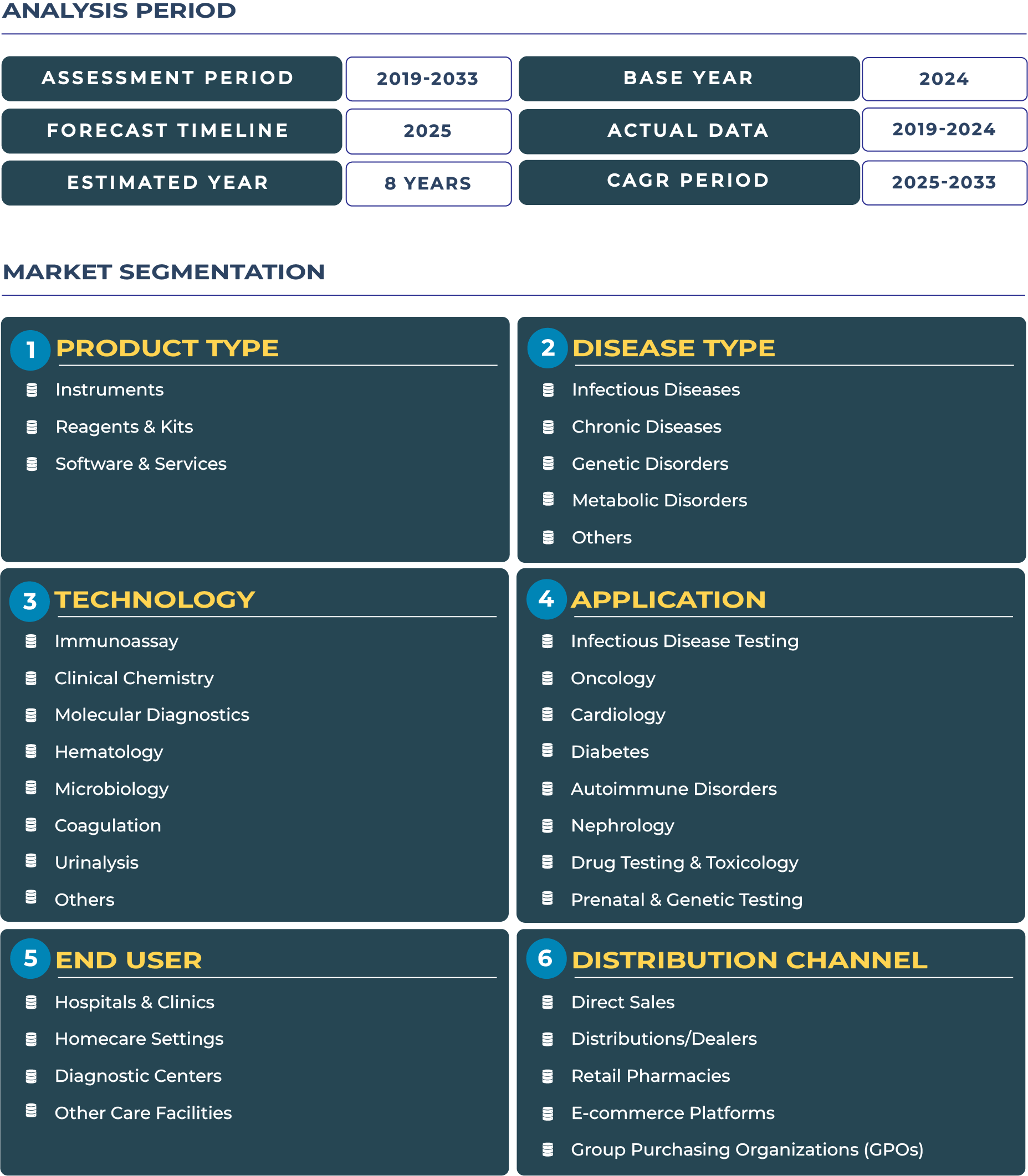India’s Diagnostic Leap: Affordability, Coverage & Orthopedic Demand Fuel IVD Surge
India’s expanding health insurance coverage and rising out-of-pocket affordability are driving deeper penetration of diagnostic services, especially in orthopedic and musculoskeletal care where preoperative screening, post-surgical monitoring, and biomarker assessments become essential. As patients in Tier-2 and Tier-3 cities gain access to advanced surgical care, diagnostic demand multiplies. In tandem with this expansion, the Indian in-vitro diagnostic (IVD) market is poised for remarkable growth: estimated at USD 5.46 billion in 2025 and projected to reach USD 13.38 billion by 2033, reflecting a robust CAGR of 11.8%. This trajectory underscores how affordability, insurance penetration, hospital expansion, and local manufacturing are reshaping India’s diagnostic ecosystem.
Market Outlook: Infrastructure Investment, Digital Integration & Demand Scale Converge
The Indian IVD market outlook is anchored in three reinforcing currents. First, public health initiatives such as Ayushman Bharat, state lab network strengthening, and diagnostic mission programs are expanding baseline test capacity into rural and underserved regions. Second, private diagnostic chains (e.g., Dr. Lal PathLabs, SRL Diagnostics) are scaling tiered networks and deploying hub-and-spoke models that bring advanced testing closer to patients. Third, digital health integration, electronic health records, lab information systems, remote result access, is enhancing workflow efficiency and enabling data-driven diagnostics. These trends facilitate higher utilization of instruments, reagent kits, and software services across diagnostic laboratories. Beneath this, the dual burden of communicable and noncommunicable diseases ensures that both routine and specialized tests remain in strong demand, equipping the Indian IVD sector with structural resilience.
Drivers & Restraints: Underpenetrated Demand Meets Structural Constraints
Underpenetrated Population, Growing Insurance, and Private Hospital Chains Drive Volume Growth
A major growth driver is India’s large underpenetrated population. Many districts lack access to accredited lab services, offering white-space potential for diagnostic providers to expand. Rising insurance penetration, through government schemes and private health plans, increases diagnostic reimbursement and uptake. Concurrently, the proliferation of private hospital chains into smaller cities is incentivizing embedded lab services. Together, these forces raise baseline diagnostic volume, pushing consumption of reagents, kits, and instrument usage upward.
Price Sensitivity, Reimbursement Gaps & Logistics to Tiers Stall Full Reach
However, India IVD market is constrained by significant challenges. Price sensitivity remains high in low-income markets, limiting margins and compelling manufacturers to offer “value-tier” solutions. Reimbursement structures vary substantially across states, often focusing on core tests while excluding advanced molecular assays. Logistics and cold-chain barriers, especially to remote or hilly regions, hamper consistent reagent supply and instrument maintenance. Skilled workforce shortages, laboratory technologists and quality assurance personnel, pose operational bottlenecks, especially for small labs. These constraints slow the pace of diagnostic modernization beyond major metro corridors.
Trends & Opportunities: Private Expansion, Domestic Innovation & Outcome-Based Models
Trend: Private Hospital Expansion, Domestic Manufacturing & Ambulatory Diagnostic Growth
One prevailing trend is the integration of diagnostic labs within private hospital chains and outpatient centers. Hospitals are increasingly offering bundled surgical + diagnostic packages, improving patient convenience and retention. On the supply side, “Make in India” policies and incentives have fostered domestic manufacturing of reagents, kits, and even certain analyzer components, reducing dependence on imports. Furthermore, ambulatory diagnostic services and point-of-care testing (POCT) are gaining traction, particularly in primary health centers and urban clinics, enabling faster turnaround for surgical decision-making.
Opportunity: Low-Cost Patient-Matched Implants, Local Manufacturing & Outcome-Based Diagnostic Financing
Opportunities lie in coupling diagnostics with orthopedic implant ecosystems: patient-matched implants require precise pre-op biomarker and imaging data, creating synergy. Diagnostic companies that align with domestic implant manufacturers can embed IVD modules into surgical workflows. Local manufacturing of reagents and consumables offers cost control and supply chain agility. Further, diagnostic service providers can pilot outcome-based financing models, where payment is tied to clinical impact or diagnostic yield, to win hospital adoption in price-controlled environments.
Competitive Landscape: Tiered Strategy, Training & Local Innovation Enable Penetration
The Indian IVD sector features both global and domestic players. Global firms like Roche Diagnostics deploy tiered strategy models, offering premium assays in metros and lean kits in smaller centers, while collaborating with local distributors. Regional chains (e.g., Dr. Lal PathLabs, SRL Diagnostics) embed labs within hospital networks to lock in test flows. Many foreign players invest in training programs for laboratory technologists and radiologists, improving adoption and quality. Others partner with local OEMs for reagent co-manufacture under licensing to lower cost and gain regulatory ease. Outcome validation studies in Indian patient cohorts serve as differentiators in procurement decisions.







